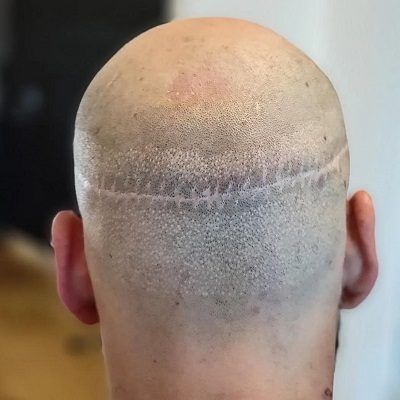Thin, fiber-like strands that originate from the scalp and eventually grow thicker and longer are called hair. Hair constitute of hair shafts, follicles, and roots. The visible development of hair is the hair shaft. While hair roots and follicles are invisible to the unaided eye. The nutrients that hair follicles supply to the hair shaft helps it grow longer and stronger and surround the hair root. When follicles do not receive enough nutrition to transmit it to the shaft, people experience hair loss. It happens when the scalp receives insufficient nutrients and there are deficiencies in a number of minerals, nutrients, and proteins. They develop baldness if the hair loss does not get treated. Therefore, people for different procedures but do not know Hair Transplant vs Prosthetic Hair: Which One is Better for them.
What is Hair Transplant?
A Hair Transplant in Dubai is a surgical technique in which the doctor moves the hair follicles from the donor site—one area of the body—to the recipient site—another area of the body. It is a permanent method that helps to restore the hair. Moreover, it also uses different techniques like FUT and FUE to transplant the hair on the scalp which ultimately helps to look the scalp full of hair.
What is Prosthetic Hair?
Prosthetic hair is a form of hair restoration technology that helps to restore lost or thinning hair. It usually consists of synthetic or human hair, and adhesive or bonding substances aid in securing it to the scalp. With the help of tape, clips, or other means, the hair is fastened to the scalp. Prosthetic hair helps to cover bald spots on the scalp or to provide the appearance of a full head of hair. Additionally, it is styled and painted to blend in with the natural hair of the wearer.
Difference Between Hair Transplant and Prosthetic Hair:
A surgical treatment known as a hair transplant helps to regrow hair in regions of the scalp that are bald or have thinning hair. It entails taking hair follicles from scalp regions that are not experiencing hair loss and transplanting them to regions that need hair growth. The newly implanted hair blends in with the surrounding hair and grows normally.
A synthetic remedy for baldness is prosthetic hair, commonly referred to as hair replacements. A complete, realistic-looking head of hair produces using synthetic or natural hair in this non-surgical hair restoration method.
Prosthetic hair is not as effective as hair transplantation for hair restoration. A hair transplant is a more long-lasting treatment and does not need any upkeep. Additionally, it has a more natural appearance and can produce a more natural hairline. The appearance of prosthetic hair may not be as realistic and it is not permanent.
Procedure:
Hair Transplant:
The doctor after examining your scalp condition and discussing the procedure with the client. He prepares him for the procedure by shaving the area of treatment. And then extracts the follicles from the back or side of the scalp and harvests them into the bald area. He uses FUE or FUT technique to complete the procedure.
Prosthetic Hair:
Selecting a wig that complements the color and texture of your own hair is a crucial step. Professional washes and dries your natural hair. To prevent uneven lumps when putting the wig, he will make sure to knot all of your hair backward after drying it. Use alcohol to clean your hairline to get rid of germs and pollutants. In order for the wig and the adhesive substance to adhere to your scalp with ease.
Utilizes a net cap or a skin-toned cap for the wig. He carefully stretches the cap before placing it on your head to ensure a flawless fit.
AfterCare:
The aftercare measures entirely impact the reliability of the surgery is entirely impacted.
- Avoid swimming and saunas.
- Keep the scalp dry.
- If prescribed medication, follow the doctor’s instructions.
- Avoid activities that could result in sweating or excessive friction on the transplanted area.
- Avoid direct sunlight and heat.
- Use a mild shampoo and avoid any harsh products.
- Do not style the hair for at least two weeks after the procedure.
Moreover, the aftercare measure for prosthetic hair are almost similar but still, there is special care required for the prosthetic hair.
- Use a wide-tooth comb to untangle the hair.
- Prefer using a leave-in conditioner to keep the wig soft.
- Use a heat-protective styling spray when styling the wig with a blow dryer or curling iron.
- Brush the wig every day.
- Wash the wig every two weeks with a mild shampoo and rinse it in cold water after each wash.
- Refrain from using strong chemical products and treatments.
Benefits:
A hair transplant is a surgical solution whereas prosthetic hair is a aesthetic solution to hair loss problems. Both are beneficial in treating hair loss. And enhancing the person’s look.
- A more realistic-appearing, long-lasting hair loss treatment is possible with hair transplants. They frequently have a high success rate and might offer a long-term remedy for hair loss.
- A non-invasive, non-surgical way to treat hair loss is with prosthetic wigs. They are more comfortable than customary wigs, lighter, and easier to wear. For a more realistic appearance, they can also be individually fitted to the wearer. For individuals who are not at ease with the concept of a hair transplant, prosthetic wigs are a fantastic alternative.
Book A Consultation!
Hair Transplant vs Prosthetic Hair: Which One is Better? Are you still thinking about this? Dynamic Clinic offers both procedures that can you treat hair loss. Moreover, we have highly qualified physicians who will help you make the best decision in treating hair loss and improving your physical appearance. So contact us without any hesitation. Complete the form and schedule a consultation.


































